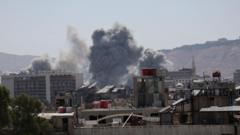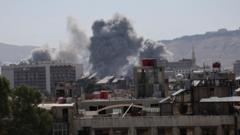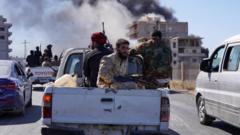The city of Baniyas has witnessed a horrifying massacre, claiming over 1,600 lives amid rampant violence and instability, challenging the new militarized government's ability to ensure safety and order in the aftermath of Syria's prolonged civil war.**
Baniyas Under Siege: A Disturbing Chapter in Post-Civil War Syria**

Baniyas Under Siege: A Disturbing Chapter in Post-Civil War Syria**
A recent surge of violence in Baniyas unveils the precarious state of peace as sectarian tensions reignite, leaving hundreds dead and countless families shattered.**
In early March, the once-bustling city of Baniyas in Syria made headlines for all the wrong reasons. Streets formerly teeming with life lay desolate, littered with charred vehicles and the remnants of small businesses stripped bare. Reports of a horrific resurgence of violence have emerged, scattering fears throughout the community as emergency responders transformed an abandoned furniture shop into a makeshift morgue filled with the sad remains of lives lost.
In graphic detail, locals share harrowing accounts as throngs of armed men wreaked havoc across the city. For three harrowing days, these gunmen targeted civilians, particularly from the Alawite sect, a group historically aligned with the regime’s elite amidst the ruins of a once-unified nation. What unfolded was an unnerving spree of killings—over 1,600 civilian lives extinguished, according to residents relaying their experiences to The New York Times. Eyewitness reports tell of executions on street corners, as armed groups seized properties and laid waste to families seeking refuge from the brutality.
Desperate family members rushed to collect their deceased loved ones caught in the crossfire, pleading for help from harried emergency workers. “There are at least 40 bodies on one road,” one man lamented, underscoring the staggering loss of life and the stark fragility of the newfound governmental authority.
Amidst these tragic events, there exists an unsettling sense of impotence among the new rebel-led government, unable to shield vulnerable communities from slaughter—a bitter legacy of the civil war's ongoing tribulations. Those left behind face an uncertain future, grappling with the unhealed wounds of trauma against a backdrop of shattered hope for a stable Syria. The crisis in Baniyas serves as a haunting reminder of the unchecked violence that continues to plague the nation, compelling observers to question whether peace can ever truly take root in the fractured country.
In graphic detail, locals share harrowing accounts as throngs of armed men wreaked havoc across the city. For three harrowing days, these gunmen targeted civilians, particularly from the Alawite sect, a group historically aligned with the regime’s elite amidst the ruins of a once-unified nation. What unfolded was an unnerving spree of killings—over 1,600 civilian lives extinguished, according to residents relaying their experiences to The New York Times. Eyewitness reports tell of executions on street corners, as armed groups seized properties and laid waste to families seeking refuge from the brutality.
Desperate family members rushed to collect their deceased loved ones caught in the crossfire, pleading for help from harried emergency workers. “There are at least 40 bodies on one road,” one man lamented, underscoring the staggering loss of life and the stark fragility of the newfound governmental authority.
Amidst these tragic events, there exists an unsettling sense of impotence among the new rebel-led government, unable to shield vulnerable communities from slaughter—a bitter legacy of the civil war's ongoing tribulations. Those left behind face an uncertain future, grappling with the unhealed wounds of trauma against a backdrop of shattered hope for a stable Syria. The crisis in Baniyas serves as a haunting reminder of the unchecked violence that continues to plague the nation, compelling observers to question whether peace can ever truly take root in the fractured country.


















